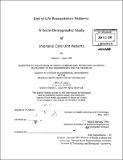| dc.contributor.advisor | Regina Barzilay. | en_US |
| dc.contributor.author | Lojun, Sharon L. (Sharon Lee) | en_US |
| dc.contributor.other | Harvard University--MIT Division of Health Sciences and Technology. | en_US |
| dc.date.accessioned | 2010-08-31T14:51:52Z | |
| dc.date.available | 2010-08-31T14:51:52Z | |
| dc.date.copyright | 2010 | en_US |
| dc.date.issued | 2010 | en_US |
| dc.identifier.uri | http://hdl.handle.net/1721.1/57804 | |
| dc.description | Thesis (S.M.)--Harvard-MIT Division of Health Sciences and Technology, 2010. | en_US |
| dc.description | Vita. Cataloged from PDF version of thesis. | en_US |
| dc.description | Includes bibliographical references (p. 49-51). | en_US |
| dc.description.abstract | This study investigates the effect of age, gender, medical condition, and daily free text input on classification accuracy for resuscitation code status. Data was extracted from the MIMICII database. Natural language processing (NLP) was used to evaluate the social section of the nurses' progress notes. BoosTexter was used to predict the code-status using text, age, gender, and SAPS scoring. The relative impact of features was analyzed by feature ablation. Social text was the greatest single indicator of code status. The addition of text to medical condition features increased classification accuracy significantly (p<0.001.) N-gram frequency was analyzed. Gender differences were noted across all code-statuses, with women always more frequent (e.g. wife>husband.) Visitors and contact were more common in the less aggressive resuscitation codes. Logistic regression on medical, age, and gender features was used to determine gender bias or ageism. Evidence of bias was found; both females (OR=1.47) and patients over age 70 (OR=3.72) were more likely to be DNR. Feature ablation was also applied to the social section of physician discharge summaries, as well as to annotated features. The addition of annotated features increased classification accuracy, but the nursing social text remained the most individually predictive. The annotated features included: children; living situation; marital status; and working status. Having zero to one child; living alone or in an institution; being divorced or widow or widower; and working, working in white collar job, or being retired, were all associated with higher rates of DNR status, and lower rates of FC status. Contrarily, living with family; being married; and being unemployed, were all associated with lower rates of DNR status, and higher rates of FC status. Some of these findings were gender and/or age dependent. | en_US |
| dc.format.extent | 110 p. | en_US |
| dc.language.iso | eng | en_US |
| dc.publisher | Massachusetts Institute of Technology | en_US |
| dc.rights | M.I.T. theses are protected by
copyright. They may be viewed from this source for any purpose, but
reproduction or distribution in any format is prohibited without written
permission. See provided URL for inquiries about permission. | en_US |
| dc.rights.uri | http://dspace.mit.edu/handle/1721.1/7582 | en_US |
| dc.subject | Harvard University--MIT Division of Health Sciences and Technology. | en_US |
| dc.title | End of life resuscitation patterns : a socio-demographic study of intensive care unit patients by Sharon L. Lojun. | en_US |
| dc.title.alternative | Socio-demographic study of intensive care unit patients | en_US |
| dc.type | Thesis | en_US |
| dc.description.degree | S.M. | en_US |
| dc.contributor.department | Harvard University--MIT Division of Health Sciences and Technology | |
| dc.identifier.oclc | 656267951 | en_US |
